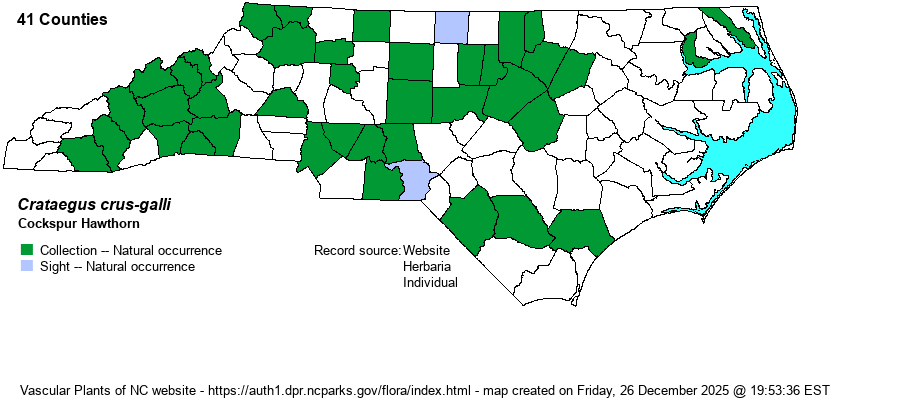| Author | L. | |
| Distribution | Scattered over most of the Mountains and the Piedmont; only a few records in the Coastal Plain. However, as it has been found in southeastern VA and in much of the SC Coastal Plain, it certainly could (or should) occur over much of this province in NC.
This is a wide-ranging species across the Eastern U.S. and southeastern Canada. It ranges south to central FL and central TX.
| |
| Abundance | This is a fairly common to common hawthorn in the Mountains and Piedmont, but is – for some odd reason -- seemingly scarce in the Coastal Plain. It can be easily overlooked or confused with several other Crataegus species, though it is a well-known and long established species, unlike some others. The S3 state rank given to it by the NC NHP seems to underestimate its frequency, and perhaps S4 would be more appropriate, if not even S5. | |
| Habitat | This is more of an early succession species than most hawthorns, especially in the mountains, where it often invades abandoned pastures and weedy fields. It also occurs in fencerows, wooded borders, and other somewhat dry and sunny places. The variety pyracanthifolia occurs mainly in bottomlands and other low ground, in the Coastal Plain. |
| Phenology | Blooms in April and May, and fruits in September and October. | |
| Identification | This is a large shrub to more often a small tree, with a wide crown (as it usually grows in the open); it may reach 20-25 feet tall. It is the most often seen hawthorn with strongly obovate leaves, gradually tapering to a narrow base and with a rounded, blunt tip. The serrations are very small. The upper surface of the leaf is typically shiny, with little evidence of indentions of the leaf veins. The leaf width can be quite variable; the leaves and twigs are generally glabrous. Several other hawthorns in the state do have such strongly obovate and scarcely serrate leaves, but you should assume you have this species until proven otherwise. Check Lance (2014) and Weakley (2018) for more detailed separation of less common or less widespread taxa. | |
| Taxonomic Comments | Though the species has been long known to be valid, recent references show that two varieties exist in the state – the nominate var. crus-galli being statewide, and var. pyracanthifolia being essentially found in the Coastal Plain and (rarely) Piedmont.
| |
| Other Common Name(s) | Cockspur Thorn | |
| State Rank | S3 [S4] | |
| Global Rank | G5 | |
| State Status | | |
| US Status | | |
| USACE-agcp | FAC link |
| USACE-emp | FACU link |

